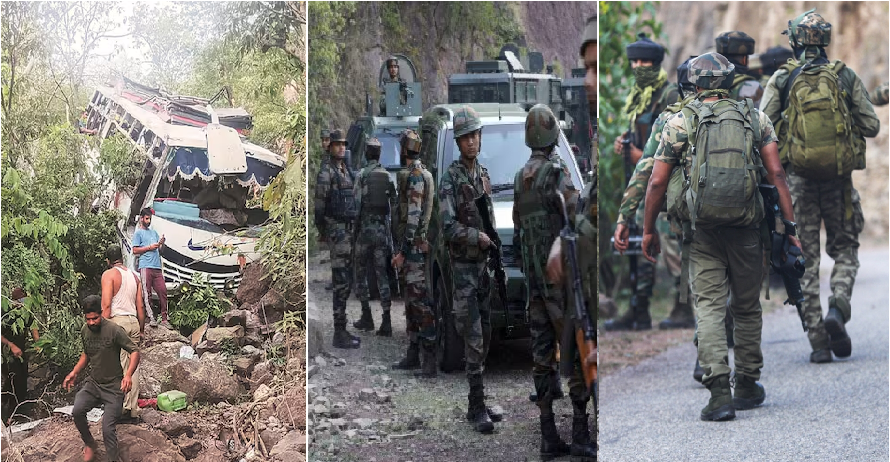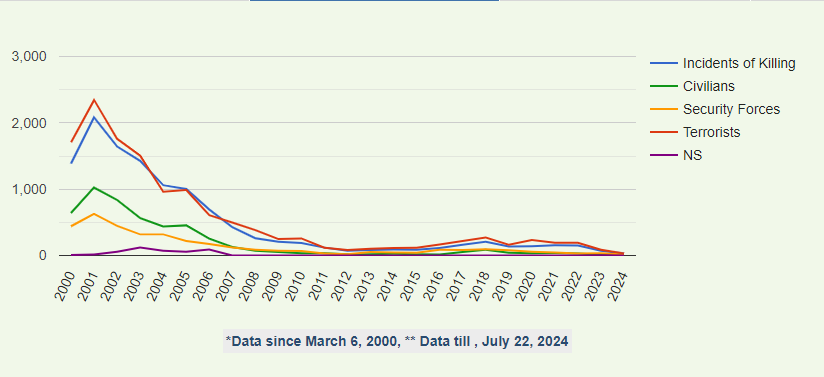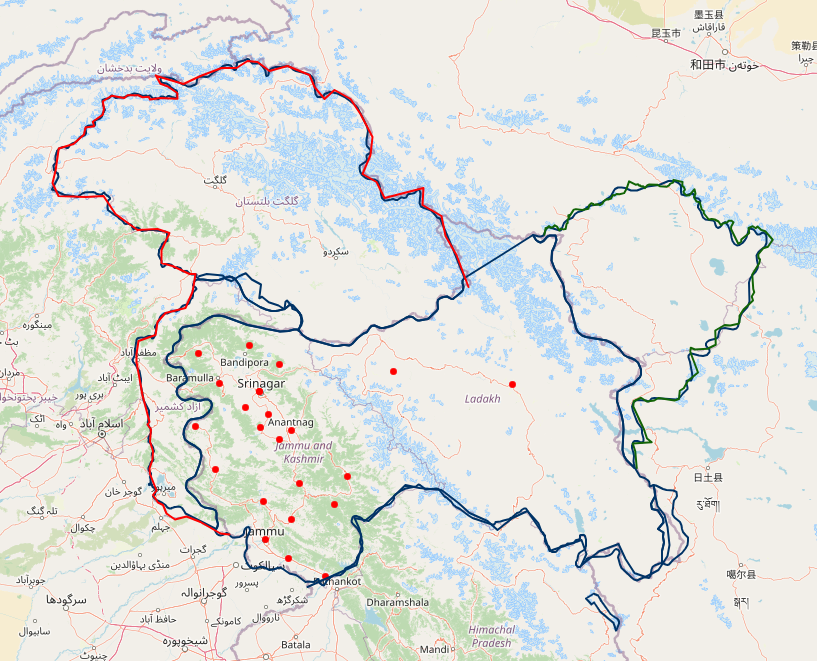
- Rise in Terrorist Activities: In 2024, there was a significant increase in terrorist activities in the Jammu region, historically less volatile than the Kashmir Valley.
- Strategic and Geopolitical Factors: Jammu’s landscape provides natural shelter for militants, making it an attractive launching pad for attacks compared to Kashmir.
- Economic Impact: Terrorist activities in Jammu aim to disrupt its major economic contributions and development initiatives, with significant investments and job creation impacted.
- Cross-Border Infiltration: Pakistan’s proximity and support to terrorist groups contribute to cross-border infiltration, exacerbating the security situation in Jammu.
The stunning valley of Jammu and Kashmir, which is frequently referred to as “heaven on earth,” has once again become a flashpoint for violence and instability. Compared to the Kashmir Valley, which was notorious for years of conflict, significant terror attacks, and instability, the Jammu region had previously been less volatile until a notable increase in terrorist activity occurred there in 2024. While the Indian government continues to work towards peace and stability in the region, the recent events in Jammu have brought attention to the constant threat posed by terrorist organisations, which is always shifting. We need to look at the causes of this unrest historically, as well as in the present and future, to comprehend the seriousness of the situation as it stands.
The insurgency in Kashmir escalated brutally during the late 1980s due to political dissatisfaction, economic marginalization, and religious indoctrination. The insurgency initially centred on the Kashmir Valley but has sometimes spilt over to Jammu over time.

In 2024, there was an increase in terrorist incidents in Jammu, with several incidents being highly publicized. These incidents have resulted in the loss of life and instilled fear among the local people. Four attacks were carried out by terrorists between June 9 and 12 in the Jammu region. The first major terror incident that rocked the nation was the Reasi terror attack on a bus full of Hindu pilgrims going to the Mata Vaishno Devi Shrine, which claimed the lives of nine innocent persons and injured over 41 individuals. A village in Kathua witnessed a gun battle, leaving two militants and one CRPF jawan dead.
The rise of terrorism in Jammu instead of Kashmir is due to strategic, geopolitical, and local factors. First, Jammu’s landscape, with its mountains and thick forests, resembles parts of Kashmir, providing natural shelter for militants; thus, it becomes an attractive launching pad for attacks. Therefore, strategies that have worked against terrorist groups in Kashmir may not apply to those operating within the distinct geopolitical landscape of Jammu.
There has been an increased security infrastructure in Kashmir over the years, making it difficult for militants to operate freely. Additionally, demographic and religious targeting by militants makes Jammu attractive compared to the Kashmir Valley in terms of its Hindu majority population, while the latter is dominated by Muslims. This can ignite tension between Muslims and Hindus in Jammu, potentially destabilizing the whole region with wider national and international implications. These attacks create feelings of insecurity among local populations, thereby putting pressure on the government.
Thirdly, Jammu is a major economic contributor in this part of India. It might be targeted to upset markets, scare people away from opportunities, or hinder development initiatives. For instance, in 2023-24, Rs 1,966 crore was invested in Jammu alone, marking a 68% hike compared to Rs 2,153 crore invested across the UT, with Rs 1,416 crore from Jammu during 2022-23. Additionally, job opportunities increased from 10,506 jobs in the fiscal year 2022-23 to 26,032 jobs by March 31, 2024.

Pakistan, often referred to as a “failed state,” could also be a contributing factor, as Jammu shares a long international border with it, making it susceptible to cross-border infiltration. Ceasefire violations are common along the Line of Control (LoC) in the Jammu region, which terrorists may exploit to infiltrate India illegally. According to security reports, terrorists are often trained and supported by terror groups from Pakistan. The recurrence of such operations and their variety of targets, from pilgrimage buses to military camps, suggests that terrorist outfits like Lashkar-e-Taiba (LeT) and Jaish-e-Mohammed (JeM) have concerted efforts aimed at maximizing their impact.
The path to peace and stability in Jammu is challenging but not insurmountable. Curbing the wave of terrorism in Jammu requires a multi-dimensional approach involving diplomacy, military intervention, socio-economic development, and psychological interventions. Enhancing intelligence capabilities, promoting inter-agency cooperation, and employing advanced technology as preemptive measures against incoming threats are crucial. Special strategies must be adopted for counter-terrorism activities in densely forested and mountainous regions due to the challenging terrain and natural cover for insurgents. Human Intelligence (HUMINT) should incorporate local communities.
The issue of terrorism cannot be solved solely through military operations; therefore, the government must continue its development initiatives to win the hearts and minds of the people. Efforts to counter radicalization should be increased, including tracking and regulating online activities that promote extremism and conducting counter-narrative campaigns. Religious leaders and community members can spread messages of peace and tolerance to counter extremist ideologies.
This rise in terrorism is a major concern that must be addressed expeditiously and consistently. It is a multifaceted problem requiring a comprehensive approach. Addressing the root causes will enable peace to return to Jammu, where beauty and diversity can be more pronounced than the fear of terror itself.
(Pritam Sarbabidya is pursuing a Master’s in Politics and International Relations at Pondicherry University. His areas of interest include India’s Foreign Policy, Defense and Security Studies, Intelligence, and Strategic Warfare. Views expressed are the author’s own)
Pritam Sarbabidya is a postgraduate in Politics and International Relations from Pondicherry University. He writes on India’s foreign policy, security and strategic affairs, with bylines in Samvada World, Modern Diplomacy, Firstpost, The Dialectics and other platforms. He tweets at @Psarbabidya. Views expressed are the author’s own.
